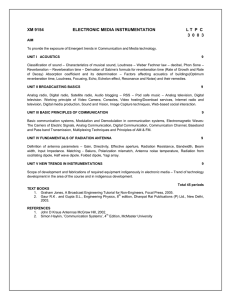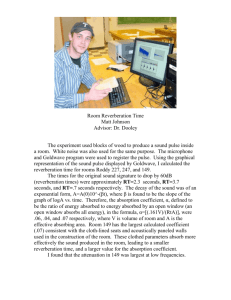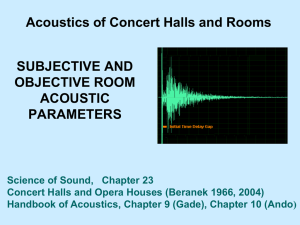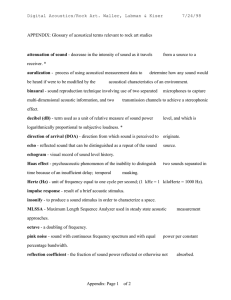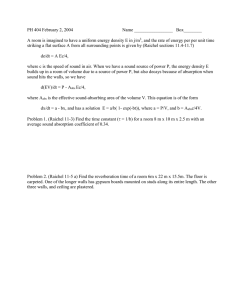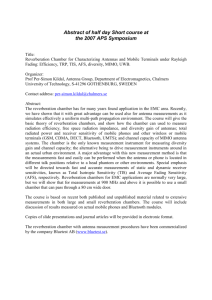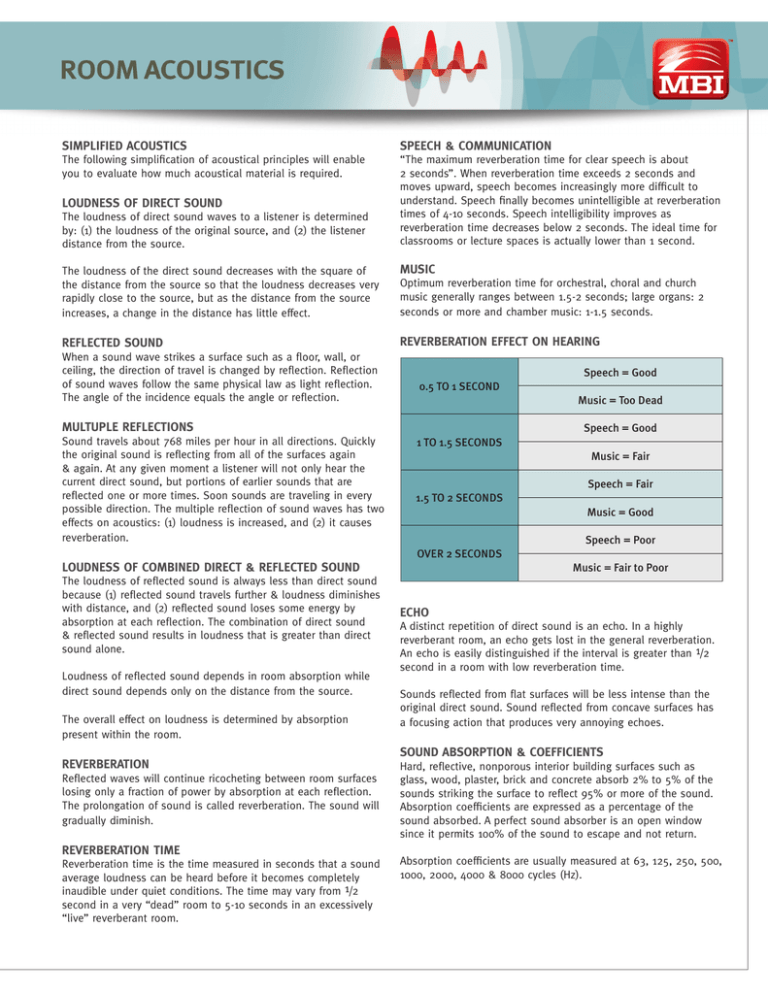
SIMPLIFIED ACOUSTICS
SPEECH & COMMUNICATION
The following simplification of acoustical principles will enable
you to evaluate how much acoustical material is required.
“The maximum reverberation time for clear speech is about
2 seconds”. When reverberation time exceeds 2 seconds and
moves upward, speech becomes increasingly more difficult to
understand. Speech finally becomes unintelligible at reverberation
times of 4-10 seconds. Speech intelligibility improves as
reverberation time decreases below 2 seconds. The ideal time for
classrooms or lecture spaces is actually lower than 1 second.
LOUDNESS OF DIRECT SOUND
The loudness of direct sound waves to a listener is determined
by: (1) the loudness of the original source, and (2) the listener
distance from the source.
The loudness of the direct sound decreases with the square of
the distance from the source so that the loudness decreases very
rapidly close to the source, but as the distance from the source
increases, a change in the distance has little effect.
MUSIC
REFLECTED SOUND
REVERBERATION EFFECT ON HEARING
When a sound wave strikes a surface such as a floor, wall, or
ceiling, the direction of travel is changed by reflection. Reflection
of sound waves follow the same physical law as light reflection.
The angle of the incidence equals the angle or reflection.
Optimum reverberation time for orchestral, choral and church
music generally ranges between 1.5-2 seconds; large organs: 2
seconds or more and chamber music: 1-1.5 seconds.
Speech = Good
0.5 TO 1 SECOND
Music = Too Dead
MULTUPLE REFLECTIONS
Sound travels about 768 miles per hour in all directions. Quickly
the original sound is reflecting from all of the surfaces again
& again. At any given moment a listener will not only hear the
current direct sound, but portions of earlier sounds that are
reflected one or more times. Soon sounds are traveling in every
possible direction. The multiple reflection of sound waves has two
effects on acoustics: (1) loudness is increased, and (2) it causes
reverberation.
LOUDNESS OF COMBINED DIRECT & REFLECTED SOUND
The loudness of reflected sound is always less than direct sound
because (1) reflected sound travels further & loudness diminishes
with distance, and (2) reflected sound loses some energy by
absorption at each reflection. The combination of direct sound
& reflected sound results in loudness that is greater than direct
sound alone.
Loudness of reflected sound depends in room absorption while
direct sound depends only on the distance from the source.
The overall effect on loudness is determined by absorption
present within the room.
REVERBERATION
Reflected waves will continue ricocheting between room surfaces
losing only a fraction of power by absorption at each reflection.
The prolongation of sound is called reverberation. The sound will
gradually diminish.
REVERBERATION TIME
Reverberation time is the time measured in seconds that a sound
average loudness can be heard before it becomes completely
inaudible under quiet conditions. The time may vary from 1/2
second in a very “dead” room to 5-10 seconds in an excessively
“live” reverberant room.
Speech = Good
1 TO 1.5 SECONDS
Music = Fair
Speech = Fair
1.5 TO 2 SECONDS
Music = Good
Speech = Poor
OVER 2 SECONDS
Music = Fair to Poor
ECHO
A distinct repetition of direct sound is an echo. In a highly
reverberant room, an echo gets lost in the general reverberation.
An echo is easily distinguished if the interval is greater than 1/2
second in a room with low reverberation time.
Sounds reflected from flat surfaces will be less intense than the
original direct sound. Sound reflected from concave surfaces has
a focusing action that produces very annoying echoes.
SOUND ABSORPTION & COEFFICIENTS
Hard, reflective, nonporous interior building surfaces such as
glass, wood, plaster, brick and concrete absorb 2% to 5% of the
sounds striking the surface to reflect 95% or more of the sound.
Absorption coefficients are expressed as a percentage of the
sound absorbed. A perfect sound absorber is an open window
since it permits 100% of the sound to escape and not return.
Absorption coefficients are usually measured at 63, 125, 250, 500,
1000, 2000, 4000 & 8000 cycles (Hz).
COEFFICIENTS OF GENERAL BUILDING
MATERIALS & FURNISHINGS
SABIN
Complete tables of coefficients of the various materials that
normally constitute the interior finish of rooms may be found in
various books on architectural acoustics. The following short list
will be useful in making simple calculations of the reverberation
in rooms.
COEFFICIENTS
MATERALS
Bricks
125
250
500
1000
2000
4000
CPS
CPS
CPS
CPS
CPS
CPS
.03
.03
.03
.04
.05
.07
A sabin is a unit of sound absorption equivalent to one square
foot having a coefficient of absorption of 1.00. A concrete floor
10,000 square feet in size and having an absorption coefficient
of .015 at 500 CPS (Hz) will yield: 10,000 x .015 = 150 sabins.
200 square feet of acoustical wall panels with an absorption
coefficient of 0.95 at 500 CPS will yield: 200 x 0.95 = 190
sabins.
FREQUENCY & REVERBERATION TIME
Quick and easy calculations can be made on the spot by doing
the calculation at 500 CPS. This is usually sufficiently accurate
for most conditions, but it is not infallible.
SABIN FORMULA
Carpet heavy on concrete Carpet with
impermeable backing .02
Concrete block, course
.08
.24
.57
.69
.71
.73
Concrete block, painted
.08
.27
.39
.34
.48
.63
Light fabric
.03
.04
.06
.07
.09
.08
Medium fabric
.07
.31
.49
.75
.70
.60
Concrete, terrazzo,
marble or glazed tile .01
.01
.02
.02
.02
.02
Wood
.15
.11
.10
.07
.06
.07
Heavy glass
.18
.06
.04
.03
.02
.02
Ordinary glass
.35
.25
.18
.12
.07
.04
Gypsum board, 1/2”
.29
.10
.05
.04
.07
.05
B) Determine acoustical absorption required:
S = V
20 T
S = Sabins (units of absorption) required in the room
V = Cubic Volume in Cubic Feet in the room
20= The Constant
S = Desired (design) reverberation time in the room
(see Reverberation Effect on Hearing)
Plaster
.01
.02
.02
.03
.04
.05
C) To calculate acoustical absorption needed:
Water surface
.01
.01
.01
.02
.02
.03
–
–
–
–
2.3
7.2
Air, sabins 1000 cubic feet
People
.06
.14
.37
.60
.65
4 sabins
N.R.C. NOISE REDUCTION COEFFICIENT
When acoustical materials are tested in a laboratory, they are
tested at 125, 250, 500, 1000, 2000 and 4000 CPS. An average of
the middle four frequencies (250, 500, 1000, 2000) is known as
the N.R.C. (Noise Reduction Coefficient). This permits rapid value
comparisons of various acoustical materials.
Named after Wallace C. Sabine, generally accepted as the
A) Determine existing reverberation (just how bad it is):
T = V
20 S
T = Reverberation time in seconds
V = Cubic Volume in Cubic Feet in the room
20= The Constant
S = Sabins (units of absorption) present in the room. This
quantity is obtained by multiplying the area of each surface
by its absorption coefficient and arriving at a total.
required sabins (part “B”)
– existing sabins (part “A”)
= sabins we need to add to the space
D) Determine how many square feet of acoustical material needed:
sabins we need to add (part “C”)
= sq. ft. required
material absorption coefficient OR
sabins we need to add (part “C”)
= panels required
sabins/panel Father of Acoustics.
This information has been provided compliments of MBI
Products Company, Inc.MBI strongly recommends that there is
no substitute for actual sound level measurements done by a
competent acoustician with the proper equipment. A thorough
professional analysis and evaluation often has better results
and a lower overall cost. A list of professional acoustical
consulting firms is available at no charge upon request.
Innovation
for the
Sound
Experience
Innovation
for the
Sound
Experience
© Copyright 1992, 2001 MBI Products Company, Inc. All rights reserved.
801 Bond
801 Street
Bond Street
Elyria, Elyria,
o hio 44035-3318
o hio 44035-3318
t: 440.322.6500
t: 440.322.6500
fx: 440.322.1900
fx: 440.322.1900
email:email:
sales@mbiproducts.com
sales@mbiproducts.com
www.mbiproducts.com
www.mbiproducts.com

